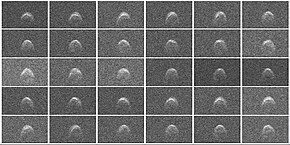(277475) 2005 WK4, provisional designation 2005 WK4, is a stony, sub-kilometer asteroid, classified as near-Earth object and potentially hazardous asteroid of the Apollo group that passed Earth within 8.2 lunar distances on 8 August 2013.[7] It was discovered on 27 November 2005, by astronomers of the Siding Spring Survey at Siding Spring Observatory, Australia.[2]
 2005 WK4 imaged 30 times by radar at Goldstone on 8 August 2013 | |
| Discovery[1][2] | |
|---|---|
| Discovered by | Siding Spring Srvy. |
| Discovery site | Siding Spring Obs. |
| Discovery date | 27 November 2005 |
| Designations | |
| (277475) 2005 WK4 | |
| 2005 WK4 | |
| Apollo · NEO · PHA[1][2] | |
| Orbital characteristics[1] | |
| Epoch 4 September 2017 (JD 2458000.5) | |
| Uncertainty parameter 0 | |
| Observation arc | 8.71 yr (3,180 days) |
| Aphelion | 1.2506 AU |
| Perihelion | 0.7707 AU |
| 1.0106 AU | |
| Eccentricity | 0.2374 |
| 1.02 yr (371 days) | |
| 81.040° | |
| 0° 58m 12.36s / day | |
| Inclination | 9.8433° |
| 138.14° | |
| 74.063° | |
| Earth MOID | 0.0037 AU · 1.4 LD |
| Physical characteristics | |
| Dimensions | 0.25±0.05 km[a] 0.284 km (calculated)[3] |
| 2.595±0.002 h[4] 2.7±0.1 h[a] 2.73±0.05 h[5] | |
| 0.20 (assumed)[3] | |
| Sk[6] · S (assumed)[3] B–V = 0.677±0.025[6] V–R = 0.446±0.019[6] V–I = 0.750±0.024[6] | |
| 20.1[1][3] | |
Description edit
In August 2013, 2005 WK4 was radar-imaged by the Deep Space Network dish at Goldstone Observatory, United States,[7] and had been observed previously at Arecibo Observatory in July 2012 (this was not a close approach though).[8]
Physical characteristics edit
2005 WK4 measures approximately 250 meters in diameter, and has a rotation period of 2.595 hours.[3][4][a] Its spectral type is that of an Sk-subtype, which transitions from the stony S-type to the uncommon K-type asteroids.[6]
See also edit
Notes edit
- ^ a b c Benner (2013): radiometric observations: mean-diameter 0.25±0.05 km; rotation period 2.7±0.1 hours. Summary figures at the LCDB; also see NASA news report
References edit
- ^ a b c d "JPL Small-Body Database Browser: 277475 (2005 WK4)" (2014-08-12 last obs.). Jet Propulsion Laboratory. Retrieved 20 January 2018.
- ^ a b c "277475 (2005 WK4)". Minor Planet Center. Retrieved 20 January 2018.
- ^ a b c d e "LCDB Data for (277475)". Asteroid Lightcurve Database (LCDB). Retrieved 20 January 2018.
- ^ a b Stephens, Robert D. (January 2014). "Asteroids Observed from CS3: 2013 July-September". The Minor Planet Bulletin. 41 (1): 13–15. Bibcode:2014MPBu...41...13S. ISSN 1052-8091. Retrieved 20 January 2018.
- ^ Behrend, Raoul. "Asteroids and comets rotation curves – (277475)". Geneva Observatory. Retrieved 20 January 2018.
- ^ a b c d e Hicks, M.; Buratt, B.; Carcione, A.; Borlase, R. (August 2013). "Broadband Photometry Of The Potentially Asteroid 277475 (2005 WK4) and Corrected 52762 (1998 MT24) Colors". The Astronomer's Telegram. 5311 (5311): 1. Bibcode:2013ATel.5311....1H. Retrieved 20 January 2018.
- ^ a b "Radar Images of Asteroid 2005 WK4". NASA. Archived from the original on 24 September 2021.
- ^ 2005WK4 - Background
External links edit
- Radar images
- Radar Images of Asteroid 2005 WK4, NASA news, 15 August 2013
- Optical image, virtualtelescope.eu
- Asteroid Lightcurve Database (LCDB), query form (info Archived 16 December 2017 at the Wayback Machine)
- Asteroids and comets rotation curves, CdR – Observatoire de Genève, Raoul Behrend
- (277475) 2005 WK4 at NeoDyS-2, Near Earth Objects—Dynamic Site
- (277475) 2005 WK4 at ESA–space situational awareness
- (277475) 2005 WK4 at the JPL Small-Body Database